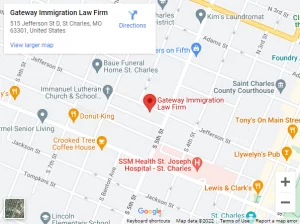Those visiting the United States on a nonimmigrant visa needing to extend, renew, or switch to another nonimmigrant visa must submit Form I-539 with US Citizenship and Immigration Services (USCIS). You need to send your application on time, without any mistakes, and attach all required documents. Consult with a St. Charles immigration attorney as soon as possible to ensure your application is correctly completed and submitted on time.
Let the immigration attorneys at Gateway Immigration Law Firm help you by showing you how to fill out Form I-539 and more.
Call our law office now to schedule a consultation with one of our Missouri immigration attorneys.
Useful Tips on Filling Out Form I-539
The Department of Homeland Security has provided guidelines for how to fill out Form I-539, Application to Extend/Change Nonimmigrant Status. The guidance is based on experience with incorrectly filled and submitted Forms I-539. Below are their tips on filling out this form:
- Check that the applicant and beneficiary’s names on Form I 539 match the names on the passport.
- Provide a copy of the applicant’s biographical page and visa stamp (if applicable) on their passport, along with a photocopy of their I-94 arrival/departure record.
- Submit a written statement explaining the impact of your extended stay on your foreign employment or residence status. For example, you could explain how you can be excused by your employer for such an extended time.
- For B-1 or B-2 extension applications, the applicant should be the one to provide the reason and explanation in print for requesting instead of the attorney.
- If a photocopy of the return ticket is not given, provide verifiable evidence that the applicant is financially capable of paying their own expense during the requested stay and has the finances to return to their home country.
- For applications seeking a change of status to F-2 or M-1 or reinstatement to F-1 or M-1, the I-20 must be signed by the designated school official (DSO) and the student. The original must also be submitted to the service. Note: the school must be an accredited college, university, seminary, conservatory, academic high school, elementary school, or other academic institution or in a language training program by the Student and Exchange Visitor Program, Immigration & Customs Enforcement. Many applicants decide and submit Form I-539 on their own. Although many cases are uncomplicated, self-filers need to proceed with care while drafting and submitting Form I-539, especially if the submission is made just before or after an incident that has changed the applicant’s legal status in the United States.
- For applications requesting for a change of visa status to F-1, submit proof of financial support/financial aid or scholarship funds for the first year of school and any dependents.
- In general, as a condition of approval, you must show that you have not received one or more public benefits listed in 8 CFR 212.21(b) for more than 12 months in any 36-month period since attaining the nonimmigrant status you want to extend or change (such that, for instance, receipt of 2 benefits in 1-month counts as two months).
You must give information about any public benefits obtained since attaining the nonimmigrant status you want to extend or change, as described in 8 CFR 212.21(b). If you are filing under one of the following categories, you do not need to supply information on your public benefits: A1, A2, G1, G2, G3, G4, NATO1, NATO2, NATO3, NATO4, NATO5, NATO6, NATO7, T1, T2, T3, T4, T5, T6, U1, U2, U3, U4, U5).
When a benefit-giving agency provides you with a public benefit, whether in the form of cash, a voucher, services, or insurance coverage, this is considered a receipt. Only public benefits obtained or attributed to you will be taken into account.
Are You Qualified to Extend Your Stay in the United States?
United States immigration law has strict rules concerning how long persons on certain visa types can stay in the United States based on the following:
- on their initial arrival;
- how much added time, they are allowed for an extension; and
- the overall length of time they can stay in the USA.
You will have to find out which rule applies to you. You must also be sure you have not violated your visa’s terms, which is quite a common problem when you:
- work illegally;
- commit a felony; or
- allow your I-94 to expire, even before filing for an extended stay or exiting the US.
Violations like these result in the immediate cancellation of one’s visa. Nonetheless, under “special situations” like natural disasters or sickness, USCIS may give exceptions or grant leniency. USCIS is reported to be conscious of the difficulties overseas travelers to the United States experienced due to the COVID outbreak, including airline cancellations. This is something that the agency considers when deciding whether or not to grant an extension.
Which Nonimmigrant Visa Categories Require the Use of the I-539 Form?
The following visa holders can (and should) use the I-539 Form for seeking an extended stay in the US:
- A (ambassadors, consular personnel or career diplomatic, public ministers, and members of their immediate families)
- A-3 (visa holders’ attendants, personal employees, and servants) as well as their close members of the family
- B-1 (temporary business visitor)
- B-2 (temporary visitors for leisure/tourism)
- CW-2 (dependents of transitional workers)
- Any dependent (child or spouse) of an E visa holder (investors and treaty traders)
- F-1 academics students are accepted to attend a public high school for a short period to study
- G (designated chief representatives of a foreign government) as well as members of an immediate family
- G5 (attendants, personal employees, and servants of foreign government officials) as well as members of an immediate family
- H-4 (dependent children and spouse of temporary specialty workers)
- K-3 (US citizen’s spouse) as well as K4 dependents (The K4 visa is a nonimmigrant visa that allows the children of a K-3 spouse visa holder to visit the U.S. while waiting for an immigrant visa)
- L2 (dependents of intracompany transferees)
- M1 (vocational students)
- N (children and parents of select special immigrants)
- NATO7 – NATO attendants, personal employees, and servants
- O3 (dependents of people with extraordinary ability)
- P4 (dependents of sportsmen and entertainers)
- R-2 (dependents of religious workers)
- TD dependents of holders of TN visas (The TN visa allows citizens of Canada and Mexico to work in the United States as NAFTA professionals in scheduled business operations for US or international companies; The TD visa is a nonimmigrant US visa, not a Green Card, that allows TN visa holders’ immediate family members to stay in the United States.)
- T (the victim of human trafficking) and dependents
- U (victim of crime) and dependents
- V (children and spouses of a particular group of permanent residents)
When a dependent who is a child applies for an extended stay, they must prove that they are still unmarried and below 21 years old.
Form I-539 Documents and Fees
You will need to provide supporting documents and pay a fee once you’ve completed the form. The required documents vary based on the type of status you are trying to have extended.
In 2022, the filing fee is $370, and an additional $85 for biometric fingerprinting, regardless of the applicant’s age, making the total $455. Only applicants transferring to or from A-1, A-2, A-3, G-1, G-2, G-3, G-4, G-5, NATO-1, NATO-2, NATO-3, NATO-4, NATO-5, or NATO-6 status are exempted from filing fees.To find the exact amount to pay, go to the “Special Instructions” section of the USCIS website on I-539. Payment can be made by money order, check, or by completing and submitting USCIS Form G-1450, Authorization for Credit Card Transactions.
Filing Form I-539 with USCIS
Many applications can only be submitted by postal mail to the appropriate address listed on the I-539 filing addresses page of USCIS. If you go that route, keep a complete duplicate of everything, along with any money order or check, for your files. This will safeguard against the genuine risk of loss in the bureaucracy.
For applicants in particular categories, online filing of I-539 forms is allowed by USCIS.
If you’re applying by yourself (with no co-applicants and with no representation of an attorney or an accredited representative) and have status as one of the following:
- B-1 (temporary business visitor)
- B-2 (temporary visitor for tourism/leisure)
- F-1 (academic student with a specific status expiry date, albeit the vast majority of students, have a “duration of status” or “D/S” expiration date)
- F-2 (spouse or child of an F-1 student having a different expiry date than the F-1 student)
- M-1 (vocational student)
- M-2 (spouse or child of an M-1 student whose status expiry date differs from that of the M-1 vocational student)
Let Gateway Immigration Law Firm Help You with Your Immigration Case!
If you have doubts regarding your eligibility or how to fill out Form I-539, the immigration attorneys at Gateway Immigration Law Firm can be of help to you.
Gateway Immigration Law Firm has been a trusted legal source of help for thousands of people in Missouri for over 15 years. Our Missouri immigration lawyers are here to help you get a green card, become a US citizen, and more. Give us a call now to schedule an appointment!







